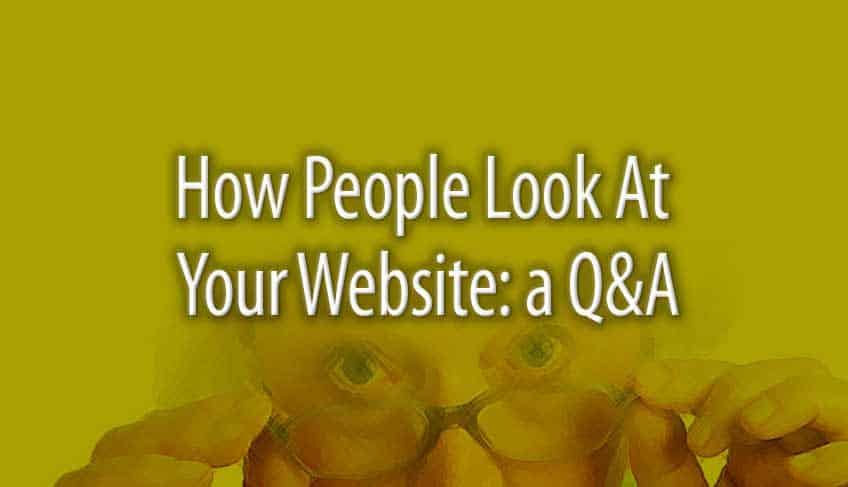
B Y T O M T O R T O R I C I
When people go to one of my web pages, where exactly does their eye first land?
It naturally lands at the upper left, but not all the way in the corner.
Then where does it go?
Left to its own devices, the viewer’s eye moves down and to the right. But of course it depends on the elements on your page and how they’re arranged.
Well, where doesn’t the eye go?
It doesn’t generally go to the edges of the page. For example, as the eye is moving down and to the right, asking it to make a sudden turn to go the left edge to begin reading your text is actually asking a lot. You can lose the visitor right there.
What about the very top of my page?
Since the eye is initially drawn by the hero image and headline in your header block, it pretty much skips over your logo – not to mention the tiny tagline under it. That’s why it’s a good idea to include the company name and tagline somewhere above the fold, closer to the page’s ‘visual center of gravity.’
What about my main menu?
Most casual visitors pretty much skip over that too. Only motivated viewers who are looking for something specific will look closer at your menu, as well as any elements, such as a phone number, in the upper right corner.
I’ve heard that the eye moves in an “F” pattern on web pages.
That’s true only for pages like a Google search results page. Most web pages are not constructed in this kind of ‘directory’ format.
What is the eye most likely to notice on my page?
It first picks up on prominent images, but it doesn’t usually spend much time on them. The second thing to be noticed are prominent headlines. Looking at this a different way, the eye is drawn to elements that offer the greatest contrast with what’s around them. A call-to-action in a bright color will get attention if most of the other colors on the page are subdued. Or, regarding tonal contrast, a spot of white will attract the eye on a page that’s mostly dark.
What else can I do to attract the eye to headlines I want people to read?
Keep some ‘air’ around it. A headline that’s in the middle of a large plain box gets more attention than one that’s placed over a photo, or one that’s crowded by other elements. Also, people are more likely to read a short headline than a long one.
How can I get the eye to dig into longer blocks of text?
Techniques for getting people to read long-form copy include a prominent introduction, bolding the first few words of every other paragraph, and including frequent section headers to break up the long text.
How can I get visitors to look at the other pages on my site?
Since we can’t depend on those tiny menu links, include throughout your home page prominent links to your most important pages/topics, accompanied by a bit of ‘teaser copy’ and maybe a small image.
Get more practical tips on engaging your web visitors by subscribing to the Optimized for Humans Blog.
Share It:
 About the Author: Tom Tortorici is an Atlanta copywriter and web content writer who helps companies make a genuine connection with their audience. His classes and conference presentations have focused on how writing, strategy and design can work together to grab attention and interest even among readers with short attention spans. In addition to working directly with businesses, Tom regularly partners with web designers and marketing agencies.
About the Author: Tom Tortorici is an Atlanta copywriter and web content writer who helps companies make a genuine connection with their audience. His classes and conference presentations have focused on how writing, strategy and design can work together to grab attention and interest even among readers with short attention spans. In addition to working directly with businesses, Tom regularly partners with web designers and marketing agencies.
All Posts/Subscribe >
Info for Businesses >
Info for Designers/Agencies >
Tom Tortorici Inc. | Tom@TomTortorici.com | 770-934-7861 | 3101 Rockaway Rd | Atlanta GA 30341
